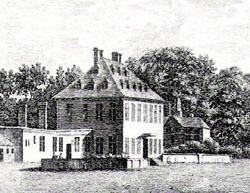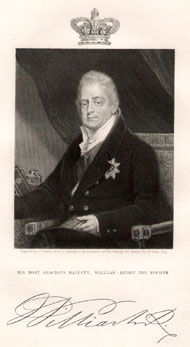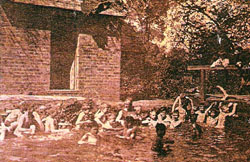Upper Lodge, Bushy Park
So named in the 1700s
1537

Bushy Park contains two historic lodges. Bushy House (formerly Lower Lodge) lies in the middle, and is still recognisable as that designed by William Samwell in 1664. Since 1900 it has been occupied by the National Physical Laboratory and is now leased to an industrial consortium. Upper Lodge near Hampton Hill, in the northwest corner, is the oldest of the occupied sites. It was rebuilt in 1709 by Charles Montagu, 1st Earl of Halifax, and rebuilt again in the 1840s into the present yellow-brick house.
Upper Lodge is surrounded by medieval ridge-and furrow ploughing which is so well integrated and aligned with the lodge itself that the two must be either contemporary or, far more likely, the lodge was already there when the land around it was ploughed. There is a strong possibility that Upper Lodge started its existence as a small Roman marching fort, standing just where the land starts to fall away to the River Thames. Ancient field edges, fence lines and roads clearly form a rectangular pattern neither medieval nor modern.
Upper Lodge was certainly there in 1537 when the land around it, then arable, was added to the Tudor North Park. It was already occupied by one John Field (also Feld or Fyld) and for a while the new park was called ‘Fyld's park'.
The Keeper of Hampton Court Palace and Chief Steward of the Honour of Hampton was also keeper of all the parks there. George Villiers, Duke of Buckingham, held the post in 1616 and assigned John Hippesley as under-keeper with Upper Lodge as his residence.
After the Restoration, the keepership of Bushy Park was given to Silius Titus who lived at Upper Lodge until 1667 when he retired to pursue a political career. Courtier and drunkard, Henry Savile, the brother of George Savile, Marquess of Halifax, followed John Lightfoot who was Keeper for around 17 years. Savile petitioned the Treasury to bring the lodge and park up to standard, but died before the work was finished. The next recorded occupant of the lodge was Fitton Gerard, third Earl of Macclesfield. In 1700 he planted an avenue of 110 elm trees leading to Upper Lodge from the south.
In 1709 year William Young, then the head keeper of all the Hampton Court Parks, died. This allowed Charles Montagu, 1st Earl of Halifax to purchase the keeperships at Hampton Court, including the reversion of Middle Park and Harewarren in Bushy Park. Upper Lodge was in a ruinous state and beyond repair. Because the cost of rebuilding was a hefty £580, the Treasury agreed to Halifax's suggestion to its exemption from the Bushy Park keepership and instead to lease it to him personally as his country residence.
The house he built was a smaller copy of the one erected 30 years earlier in the Middle Park. It faced southwards along the avenue of elms planted by Lord Macclesfield. Halifax also diverted the canal, by now known as The Longford River, into a new high pond by the lodge to feed a Cascade down to a second pond before discharging into the original system. It had cost him over £1000 to rebuild the lodge and the garden walls, erect the brewhouse and to plant the orchard and gardens.
When Halifax died suddenly in 1715, the head keepership of the Hampton Court Parks went to his nephew, George Montagu. He was given the three keeperships on condition he completed the improvements at his own expense, which he did too much acclaim. With his death in 1771, the distinction between the three parks had disappeared and the office of Ranger, which had by now replaced that of Keeper, reverted to the monarch.

In 1797, William, Duke of Clarence, succeeded as Ranger and treated Bushy as his personal estate in an effort to improve his finances. When he died, he left instructions for the appointment of the much-loved Queen Adelaide to the post of Ranger in his stead, and orders for the free admission of the public to Bushy Park.
By 1850 Bushy Park looked more or less as it does today. The Park was a popular destination for London day-trippers enjoying the new craze of cycling.

After WW1, King George V gave permission for Upper Lodge to become a convalescent home for Canadian troops. Later he granted the building to the London County Council as a holiday school for East End boys with respiratory diseases.
In 1942 the American Eighth Army Air Force established the temporary Camp Griffiss in the Park, named after the first US officer to be killed in Europe. In 1944 General Eisenhower requisitioned part of the camp as the Supreme Headquarters of the Allied Expeditionary Force (SHAEF). The camp was finally demolished in the early 1960s.
Upper Lodge was transferred in 1945 from the Air Ministry to the Admiralty, who dug the Admiralty Cut to divert the Longford River from feeding the pools at Upper Lodge. The still water in the upper pool was then used for testing mines.
The Ministry of Defence finally relinquished the lease to The Crown Estate in 1994. The north side of the site, including the house, has been sold for residential development. The south side includes the remains of Halifax's once splendid ornamental Cascade and canal described in 1729 by garden designer Stephen Switzer as: '…. without doubt one of the best works of that kind in England, and perhaps as good as any else where'. These gardens form part of the restoration proposals in Bushy Park to be carried out by The Royal Parks.
Further reading:
Kathy White and Peter Foster, Bushy Park - Royals, Rangers and Rogues, Foundry Press, 1977
Henry Ripley, The History and Topography of Hampton on Thames, 1884
Water Glittered Everywhere, John Harris, Country Life, January 6, 2000
Christopher K Currie, Archaeological excavations at Upper Lodge, Bushy Park, 1997-99, Post Medieval Archaeology, Volume 37, Part 1, 2003




